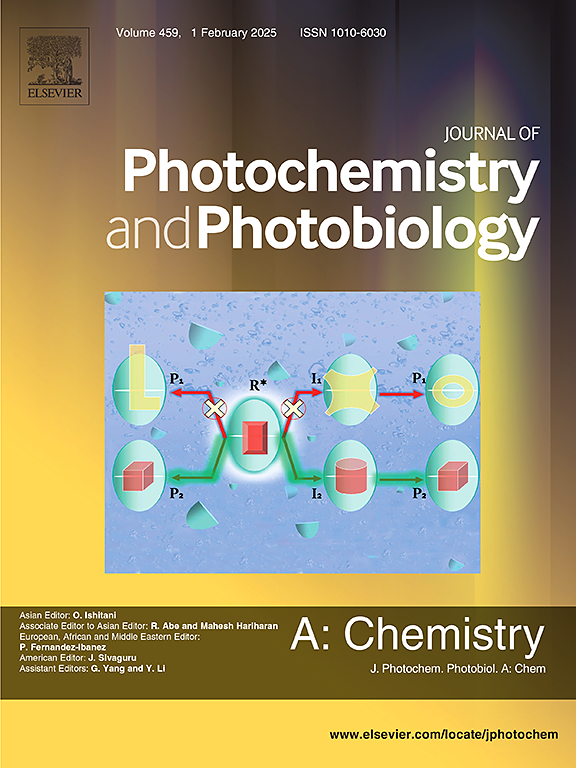Multilayer Au@SiO2@Ag@SiO2 composites enhanced surface Raman scattering for non-destructive trace detection
IF 4.1
3区 化学
Q2 CHEMISTRY, PHYSICAL
Journal of Photochemistry and Photobiology A-chemistry
Pub Date : 2025-04-09
DOI:10.1016/j.jphotochem.2025.116439
引用次数: 0
Abstract
In this work, a multilayer core–shell nanostructure with gold nanorods as the core and SiO2, Ag, and SiO2 shells, Au@SiO2@Ag@SiO2, was prepared and applied for trace detection by studying their Surface-enhanced Raman Scattering (SERS) properties. The silver layer thickness of this multilayer-coated composite nanomaterial was modified by changing the amount of AgNO3 used during synthesis. Elemental mapping was employed to confirm the layered structure of Au@SiO2@Ag@SiO2. Raman scattering intensities were measured using Au@SiO2@Ag@SiO2 as the substrate and Rhodamine 6G (R6G), thiram, melamine, and piroxicam as the probe molecules. The detection limits of these probes were 10−9 M, 10−6 M, 10−3 M, and 10−3 M, respectively. The outer SiO2 layer effectively protected Ag from oxidation, and the assay exhibited very stable reproducibility and repeatability. The multilayer Au@SiO2@Ag@SiO2 nanocomposite proposed in this study broadens the application of surface-enhanced Raman spectroscopy.

多层Au@SiO2@Ag@SiO2复合材料增强表面拉曼散射用于非破坏性痕量检测
本研究制备了以金纳米棒为核心,SiO2、Ag 和 SiO2 为外壳的多层核壳纳米结构 Au@SiO2@Ag@SiO2,并通过研究其表面增强拉曼散射(SERS)特性将其应用于痕量检测。通过改变合成过程中 AgNO3 的用量,改变了这种多层涂层复合纳米材料的银层厚度。元素图谱被用来确认 Au@SiO2@Ag@SiO2 的层状结构。以 Au@SiO2@Ag@SiO2 为基底,以罗丹明 6G(R6G)、噻拉姆、三聚氰胺和吡罗昔康为探针分子,测量了拉曼散射强度。这些探针的检测限分别为 10-9 M、10-6 M、10-3 M 和 10-3 M。外层的二氧化硅层有效地保护了银不被氧化,检测结果具有非常稳定的重现性和重复性。本研究提出的多层 Au@SiO2@Ag@SiO2 纳米复合材料拓宽了表面增强拉曼光谱的应用范围。
本文章由计算机程序翻译,如有差异,请以英文原文为准。
求助全文
约1分钟内获得全文
求助全文
来源期刊
CiteScore
7.90
自引率
7.00%
发文量
580
审稿时长
48 days
期刊介绍:
JPPA publishes the results of fundamental studies on all aspects of chemical phenomena induced by interactions between light and molecules/matter of all kinds.
All systems capable of being described at the molecular or integrated multimolecular level are appropriate for the journal. This includes all molecular chemical species as well as biomolecular, supramolecular, polymer and other macromolecular systems, as well as solid state photochemistry. In addition, the journal publishes studies of semiconductor and other photoactive organic and inorganic materials, photocatalysis (organic, inorganic, supramolecular and superconductor).
The scope includes condensed and gas phase photochemistry, as well as synchrotron radiation chemistry. A broad range of processes and techniques in photochemistry are covered such as light induced energy, electron and proton transfer; nonlinear photochemical behavior; mechanistic investigation of photochemical reactions and identification of the products of photochemical reactions; quantum yield determinations and measurements of rate constants for primary and secondary photochemical processes; steady-state and time-resolved emission, ultrafast spectroscopic methods, single molecule spectroscopy, time resolved X-ray diffraction, luminescence microscopy, and scattering spectroscopy applied to photochemistry. Papers in emerging and applied areas such as luminescent sensors, electroluminescence, solar energy conversion, atmospheric photochemistry, environmental remediation, and related photocatalytic chemistry are also welcome.

 求助内容:
求助内容: 应助结果提醒方式:
应助结果提醒方式:


